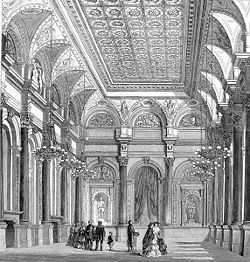
Worshipful Company of Clothworkers
Encyclopedia

Royal Charter
A royal charter is a formal document issued by a monarch as letters patent, granting a right or power to an individual or a body corporate. They were, and are still, used to establish significant organizations such as cities or universities. Charters should be distinguished from warrants and...
in 1528, formed by the amalgamation of its two predecessor Companies, the Fullers (incorporated 1480) and the Shearmen (incorporated 1508). It succeeded to the position of the Shearmen’s Company and thus ranks twelfth in the order of precedence of Livery Companies of the City of London
City of London
The City of London is a small area within Greater London, England. It is the historic core of London around which the modern conurbation grew and has held city status since time immemorial. The City’s boundaries have remained almost unchanged since the Middle Ages, and it is now only a tiny part of...
.
The original craft of the Clothworkers was the finishing of woven woollen cloth: fulling
Fulling
Fulling or tucking or walking is a step in woolen clothmaking which involves the cleansing of cloth to eliminate oils, dirt, and other impurities, and making it thicker. The worker who does the job is a fuller, tucker, or walker...
it to mat the fibres and remove the grease, drying it on tenter frames (from which derives the expression ‘to be on tenterhooks’), raising the nap with teasels (Dipsacus
Dipsacus
Dipsacus is a genus of flowering plant in the family Dipsacaceae. The members of this genus are known as teasel or teazel or teazle. The genus includes about 15 species of tall herbaceous biennial plants growing to tall...
) and shearing it to a uniform finish. The Ordinances
Bylaw
By-law can refer to a law of local or limited application passed under the authority of a higher law specifying what things may be regulated by the by-law...
of The Clothworkers’ Company, first issued in 1532 and signed by Sir Thomas More, sought to regulate clothworking, to maintain standards and to protect approved practices.
From the later Middle Ages, cloth production gradually moved away from London, a situation exacerbated by the Great Fire of London
Great Fire of London
The Great Fire of London was a major conflagration that swept through the central parts of the English city of London, from Sunday, 2 September to Wednesday, 5 September 1666. The fire gutted the medieval City of London inside the old Roman City Wall...
and the Industrial Revolution
Industrial Revolution
The Industrial Revolution was a period from the 18th to the 19th century where major changes in agriculture, manufacturing, mining, transportation, and technology had a profound effect on the social, economic and cultural conditions of the times...
of the 18th and 19th centuries. The charitable role of The Clothworkers’ Company nevertheless continued, supported by generous gifts of money and property by members and benefactors.
Nowadays, the Company’s main role is in the charitable sphere, through The Clothworkers’ Foundation, an independent charity. Through its grants, the Foundation seeks to improve the quality of life, particularly for people and communities that face disadvantage.
Both the Company and the Foundation operate from Clothworkers’ Hall, in Dunster Court, off Mincing Lane
Mincing Lane
Mincing Lane is a one-way street in the City of London linking Fenchurch Street southward to Great Tower Street.Its name is a corruption of Mynchen Lane - so-called from the tenements held there by the Benedictine 'mynchens' or nuns of St Helen's Bishopsgate .It was for some years the world's...
in the City of London. The site was conveyed to a group of Shearmen in 1456 and the present building, completed in 1958, is the sixth on the site.
Famous Clothworkers include James I of England
James I of England
James VI and I was King of Scots as James VI from 24 July 1567 and King of England and Ireland as James I from the union of the English and Scottish crowns on 24 March 1603...
, Samuel Pepys
Samuel Pepys
Samuel Pepys FRS, MP, JP, was an English naval administrator and Member of Parliament who is now most famous for the diary he kept for a decade while still a relatively young man...
, Prince Albert of Saxe-Coburg and Gotha, Angela Burdett-Coutts, 1st Baroness Burdett-Coutts
Angela Burdett-Coutts, 1st Baroness Burdett-Coutts
Angela Georgina Burdett-Coutts, 1st Baroness Burdett-Coutts , born Angela Georgina Burdett, was a nineteenth-century philanthropist, the daughter of Sir Francis Burdett, 5th Baronet and the former Sophia Coutts, daughter of banker Thomas Coutts...
, George Peabody
George Peabody
George Peabody was an American-British entrepreneur and philanthropist who founded the Peabody Trust in Britain and the Peabody Institute in Baltimore, and was responsible for many other charitable initiatives.-Biography:...
, Sydney Waterlow
Sydney Waterlow
Sir Sydney Hedley Waterlow, 1st Baronet, KCVO was an English philanthropist and politician, principally remembered for donating Waterlow Park to the public as "a garden for the gardenless"....
, Edward VII, Lord Kelvin, William Slim, 1st Viscount Slim
William Slim, 1st Viscount Slim
Field Marshal William Joseph "Bill"'Slim, 1st Viscount Slim, KG, GCB, GCMG, GCVO, GBE, DSO, MC, KStJ was a British military commander and the 13th Governor-General of Australia....
, Robert Menzies
Robert Menzies
Sir Robert Gordon Menzies, , Australian politician, was the 12th and longest-serving Prime Minister of Australia....
and the Duke of Kent
Duke of Kent
Duke of Kent is a title which has been created various times in the peerages of Great Britain and the United Kingdom, most recently as a royal dukedom for the fourth son of George V.-Pre-history:...
.

